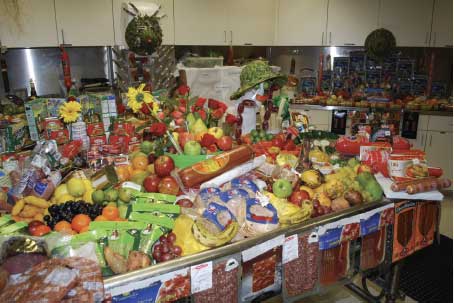Advocacy in action: How safe are our borders?
Agricultural inspections at the nation’s border had been the responsibility of USDA’s Animal and Plant Health Inspection Service since 1972. In early 2004, President Bush issued Homeland Security Presidential Directive 9, which officially recognized agriculture and the food supply as a critical infrastructure. The policy directed the Department of Homeland Security (DHS) to coordinate the effort to enhance the protection of agriculture and the food supply. To this end, the role of border inspections for agricultural products was transferred to Customs and Border Protection (CBP) within DHS.
This move raised concerns among agriculture stakeholders that the function of agricultural inspections at the border would become marginalized within the larger mission of CBP, particularly considering the lack of expertise within DHS on agricultural issues. These concerns seemed justified as complaints began to emerge from agriculture inspectors within the agency. There were accusations that DHS was not providing adequate resources and training to allow the inspectors to fulfill their mission. By 2007, stakeholders were beginning to call for border inspections to return to USDA where the expertise and focus existed to provide the best opportunity to insure the proper training, and emphasis was placed on preventing the introduction of animal and plant pests and pathogens into the United States.
As a result of stakeholder complaints and congressional concerns, DHS began to reevaluate its emphasis on agricultural protections. Reportedly, the department recognized the need for additional training and resources and committed itself to a renewed focus on preventing the incursion of agriculture pests and diseases brought in by international passengers, mail, and cargo. In December 2010, a number of swine producers and veterinarians had an opportunity to visit with CBP personnel in Miami to review their activities and discuss our concerns.
Customs and Border Protection officials in Miami offered the participants a behind-the-scenes tour of their inspection activities at the Miami International Airport, the Port of Miami, and the US Postal Foreign Mail Facility. Miami is reportedly one of the largest incursion points, if not the largest, for agricultural products in the United States.
Miami International Airport
There are 175 agricultural specialists on staff with CBP at the airport. They inspect passengers and luggage from 185 international flights per day. These inspections result in approximately 46 interceptions of prohibited materials daily (including 36 meat seizures, of which 26 are pork). All fruits, vegetables, and pork products are confiscated and disposed of via garbage disposal or incineration. Interestingly, some meat products are allowed entry depending on their origination. This poses a bit of a challenge for inspectors to determine the true origin of these products. Perhaps it would make sense to follow the lead of countries like Australia and New Zealand and just ban international travelers from carrying any agricultural products altogether.
Agricultural products confiscated during a 5-day period prior to our visit to Miami International Airport.  Photo courtesy of Mike King, National Pork Board |
Customs and Border Protection also maintains a K-9 corps to aid in inspection of passengers, luggage, cargo, and parcels. This group of highly specialized dogs are trained to “alert” when they detect meat, vegetables, fruits, or plants.
Foreign Mail Facility
All incoming international packages arriving at this facility are inspected by customs officials. This equates to approximately 160,000 packages monthly, with holiday months particularly heavy. Each package is scanned and x-rayed. Inspectors report finding considerable quantities of meat products, including pork. Most seizures originate in packages shipped from Mexico and Central and South America, with Mexico providing the greatest volume of international packages coming into the United States. Packages originating in Europe transit through New York rather than Miami. In case you’re wondering, packages shipped via carriers such as FedEx or UPS are also inspected by customs officials stationed at those facilities.
Port of Miami
Customs and Border Protection officials are responsible for the inspection of all incoming cargo vessels, cruise ships, and passengers entering the Port of Miami and the Miami River. The agency employs 31 agricultural specialists at the port. All incoming cargo is accompanied by a manifest, which aids CBP officials in the inspection process. Only approximately 10% of the cargo is inspected. Inspectors are looking for agricultural pests including insects, larvae, and eggs. A pest identification specialist identifies the pests and determines any necessary corrective action such as fumigation. Officials noted that the Dominican Republic and Haiti are of particular concern due to their proximity to the United States and myriad of diseases and pests.
Conclusions
It is evident that CBP officials in Miami are focused on agricultural issues and take their jobs seriously. During discussions, officials seemed satisfied with the level of training and resources they are currently receiving. They indicated that access to intelligence regarding cargo and passengers has been enhanced since their move to DHS, and it was the general consensus that they were better able to fulfill their mission under DHS than under USDA. Of course, as always, they could do more with more, such as additional personnel.
I think it was the general opinion of our group that the situation in Miami was better than we expected. Of course, you would always like to have more inspections, and instituting a complete ban on international passengers carrying any agricultural products into the United States would be helpful. There are still gaps which additional resources could help close. It’s obviously a concern when the inspectors find this much illegal material, considering the small percentage of flights and passengers actually inspected (approximately 16% of passengers). Also, it would be interesting to know how much of the confiscated product was actually harboring some disease pathogen or pest. Currently, all confiscated material is destroyed without further testing.
Additional education targeting international travelers would also be helpful. Instituting inspections in the country of origin, such as the Passenger Pre-inspection Program (PPIP) in the Dominican Republic, has been recognized to be beneficial as well. Unfortunately, the PPIP was discontinued this year to reallocate resources, even though USDA agreed the program had been successful (177,500 lb of meat products were confiscated under PPIP in fiscal year 2010 – that’s product that never left the Dominican Republic or had the chance to enter the United States).
It’s also important to note that we visited officials only in Miami, and while things seem positive in Miami, how representative is that of the preparedness at other customs locations nationwide? A subset of our group had recently visited another large point of embarkation and came away less impressed. So while it appears we are making progress, and DHS has recognized the need to emphasize agriculture training, there’s always room for improvement and a need for additional resources.
We have to be vigilant every day, and that includes producers and veterinarians. We’re all in this together. If you see something suspicious, report it. And remember, you can be a vector of disease transmission yourself as evidenced recently in South Korea where it appears likely that veterinary inspectors may have inadvertently spread foot-and-mouth disease.
— Harry Snelson, DVM
